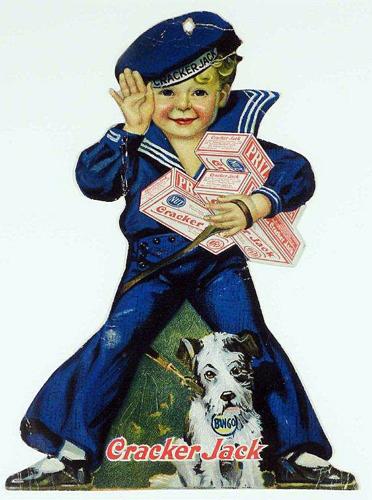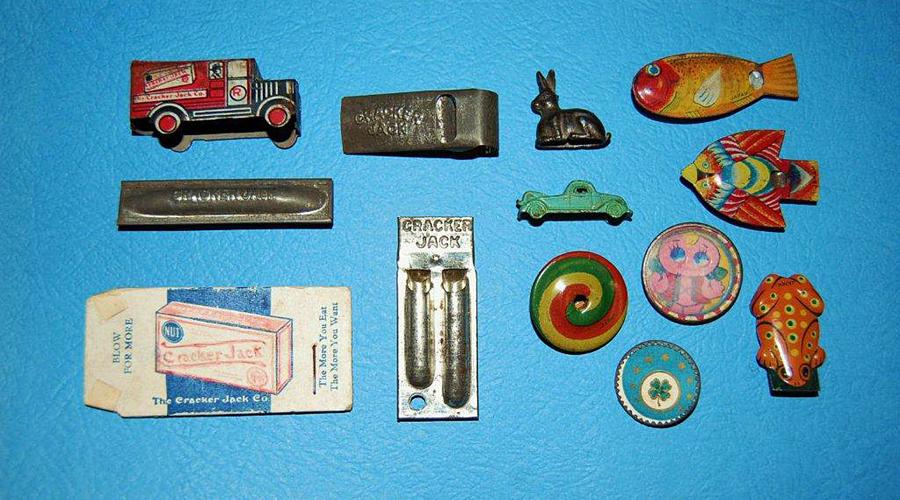What’s the first thing you think of when you hear the words “Cracker Jack”?
Is it baseball and the song “Take Me Out to the Ballgame,” or perhaps the 1960s television jingle “Candy-coated popcorn, peanuts and a prize ... that’s what you get in Cracker Jack!”? Maybe it’s the scene from the movie “Breakfast at Tiffany’s,” where the jeweler is asked to engrave a Cracker Jack ring and he replies, “Do they still really have prizes in Cracker Jack boxes?”
More than likely, that’s exactly what comes to mind — the toy surprise that was hidden inside each and every sweet, crunchy box of Cracker Jack.
Just ask anyone who grew up in the 20th century, and the answers are sure to be the same because Cracker Jack has been around for 120 years, and prizes have been included in the boxes for 101 years. Today, collectors go nuts for antique and vintage Cracker Jack toys. Collector clubs, books and Internet sites dedicated to the hobby are popping up all over the place.
CRACKER JACK HISTORY
It all began back in the late 1800s when Frederick “Fritz” Rueckheim came to America from Germany to work on the rebuilding of Chicago after the great fire of 1871. Eventually, Fritz found his calling as a popcorn vendor, selling from a cart on the city’s sidewalks. In the early 1890s, he concocted a recipe for molasses-coated popcorn and peanuts, and with the help of his brother, Louis, they developed a way to mass produce the crunchy treat.
The Rueckheim brothers first introduced “Candy Coated Popcorn & Peanuts” at the Chicago World’s Fair in 1893. The name Cracker Jack came about in 1896 after a person sampling the product exclaimed, “That’s a cracker jack!” (At the time, “cracker jack” was a slang term used to describe something that was innovative or marvelous.)
In 1899, the Eckstein Triple Proof Wax Sealed Package was patented, guaranteeing that every box of Cracker Jack would be fresh, clean and moisture-free. In 1902, Henry Eckstein, the package inventor, became a co-owner of the Cracker Jack company, and the name of the firm was changed to Rueckheim Bros. & Eckstein.
ADVERTISING AND MASCOTS
The company’s earliest mascots were the Cracker Jack bears — a pair of illustrated, anthropomorphic brown bears introduced in a 1907 marketing campaign that offered a set of 16 colorful postcards in exchange for 10 box sides featuring the slogan “The More You Eat the More You Want.” The postcards are rare and can sell for anywhere between $15 and $75 each depending on condition. The imagery is charming, showing the bears dressed appropriately for 16 different Cracker Jack-related activities.
The illustration subjects include tourism of great American landmarks such as Niagara Falls, the Statue of Liberty and the White House with President Roosevelt; visiting a peanut farmer; husking and popping corn; and playing baseball. (A complete set of 16 postcards in excellent, unused condition sold for more than $700 in 2009.)
Sailor Jack and his dog, Bingo, made their debut as the official patriotic mascots, decked out in red, white and blue, in 1918. Sailor Jack was actually based on Fritz and Louis Rueckheim’s 8-year-old nephew, Robert Rueckheim, who tragically died of pneumonia shortly after his image began to appear on the box. Bingo was modeled after Eckstein’s beloved dog, Russell, whom he had adopted as a stray.
TOY SURPRISE
In 1908, Cracker Jack was written into the lyrics of the song “Take Me Out to the Ball Game” with the words “Buy me some peanuts and Cracker Jack, I don’t care if I ever get back.” This free advertising served to increase the popularity of Cracker Jack at ball games.
In 1912, the company hit a grand-slam right out of the ball park when they decided to put a prize in every box. The earliest prize promotion, which cleverly guaranteed that customers would come back for more, was a baseball-card series that featured 144 different players. Not only was it a fitting tribute to the link between Cracker Jack and America’s favorite pastime, it was marketing genius. A second card series was introduced in 1915.
Over the decades, the toy surprises have changed from baseball cards and cardboard squeakers to celluloid pin-back buttons and tiny molded trinkets. There have also been cast-metal cars and boats, and colorful tin whistles, spinners and clickers. In the 1950s, decoder rings, necklace charms and metal figures were popular. Beginning in the 1960s, molded plastics came on the scene, followed by fake tattoos, stickers and other paper doodads. When it comes to collectors, they especially seek out the pre-plastic prizes and vintage items that feature early advertising, the words Cracker Jack or the images of Sailor Jack and Bingo.
Although Cracker Jack has seen many changes (it was bought by Borden in 1964 and sold again in 1997 to Frito-Lay), one thing has remained the same — give or take some peanuts — and that is the original recipe. It still tastes the same as it did when you were a kid, and eating Cracker Jack, while searching for the “toy surprise inside,” is more than a crunchy treat — it’s a sweet trip down memory lane.
Julie Robinson Robards is an antiques journalist and dealer living in Upper Jay. She is the author of two published books on celluloid, an advisor to several antique price guides and a writer for AntiqueWeek Newspaper since 1995. She may be reached through her website www.celluloidforever.com.






















Commented
Sorry, there are no recent results for popular commented articles.